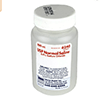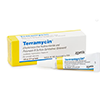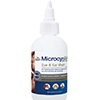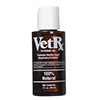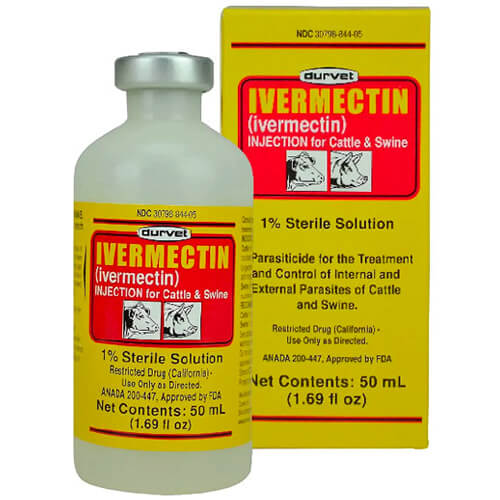Eye Infections In Chickens: 12 Causes & Treatments
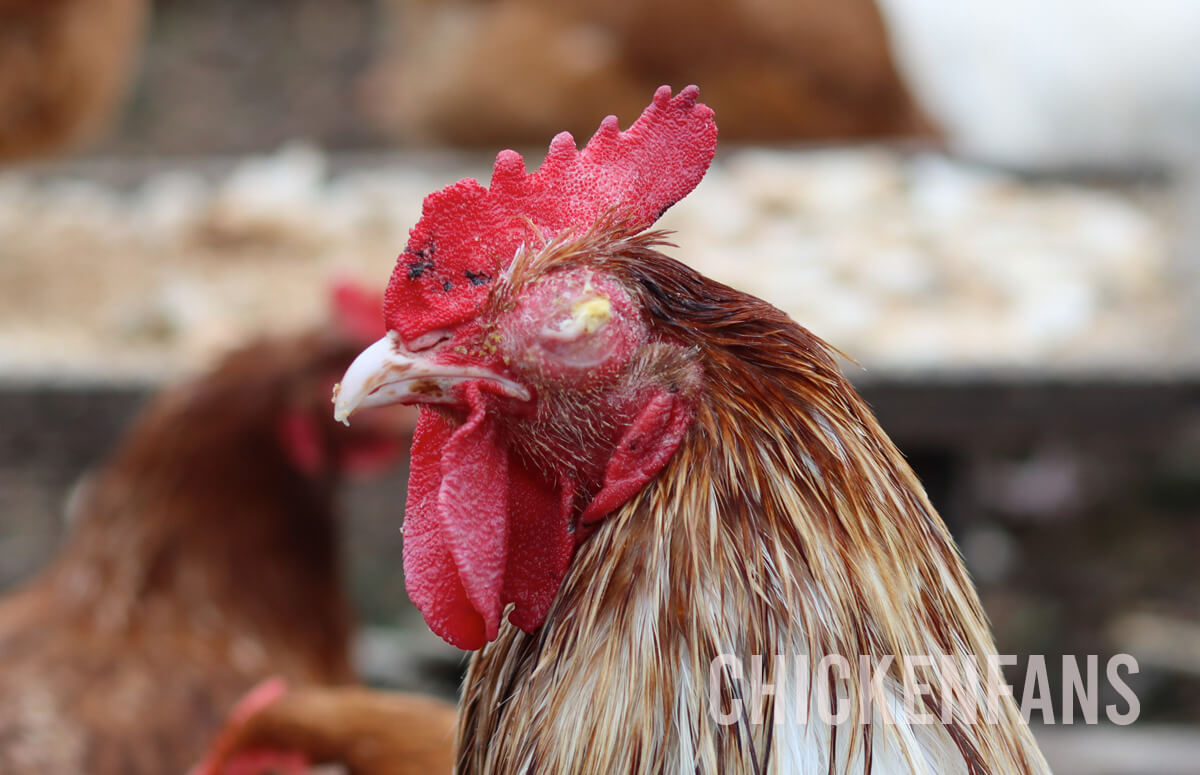

Chicken Fans is reader-supported. When you buy through our links, we may earn a commission. Learn more about our privacy policy and disclaimer.
The avian eye is an incredible organ. However, it is also delicate and, therefore, sensitive to infection. Eye infections in chickens are common and can develop independently or as a part of more complex conditions.
This article discusses the most common causes of eye infections in chickens and gives treatment tips and instructions.
For those who are just looking for treatment solutions, here are the essential products:
- To rinse, turn the chicken on its side and drop the saline solution in the eye. Try to keep the eye open while flushing.
- For eye infections, apply Terramycin 2 to 4 times daily. Terramycin is a broad-spectrum antibiotic treatment.
- Rinse the eye with MicrocynAH Eye Wash to clean the eye. This will prevent further infections and helps your chickens see clearly.
- For eye infections due to respiratory issues: Place a few drops of warm VetRx down the throat of the bird at night. Or dissolve VetRx in the drinking water (one drop for one cup).
- Sprinkle a scoop of probiotics supplement on your birds’ food on a daily basis. Helps promote a healthy digestive system.
- Adding Yucca schidigera extract to the feed is helpful in case of eye infections caused by ammonia fumes.
- In case of eye worm, use Ivermectin. Spread the feathers on the neck and apply the drops immediately on the skin of the chicken.
What Are Eye Infections In Chickens?
Eye infection or conjunctivitis (red eye) is an infection of the chicken’s conjunctiva – the membrane covering the eye’s surface and inner parts of the eyelids.
The infection can affect one or both eyes – unilateral and bilateral. Based on origin, there are three types of eye infections in chicken:
- Localized Conjunctivitis: Caused by a pathogen or irritant affecting the eye itself
- Secondary Conjunctivitis: Develops as a secondary complication due to orbital and periorbital issues like sinusitis or rhinitis
- Systemic Conjunctivitis: Part of a systemic infection that affects multiple organs and systems
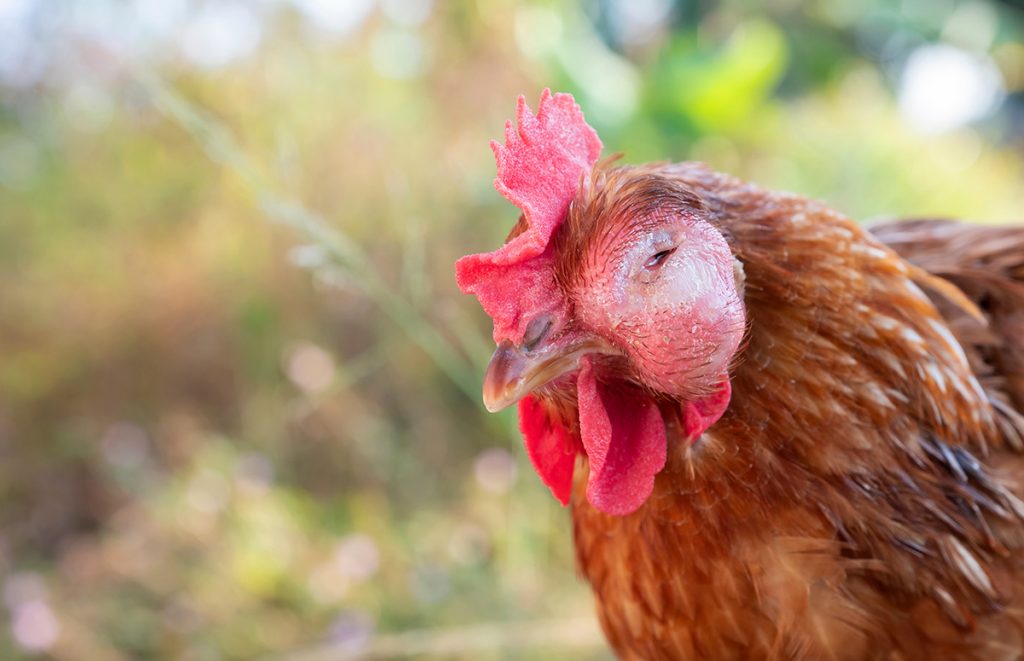
How To Treat Eye Infections In Chickens?
Treating eye infections in chickens is a multimodal process with three main aspects: supportive care, symptom management, and treating the underlying cause.
General Supportive Care
The first step to supportive care is isolating the sick chicken. Ideally, it should be placed in a safe, warm, and comfy place (the analog of hospital intensive care units).
The place must be stress-free and allow easy access to food and fresh drinking water.
Symptom Management
This step focuses on the eye itself and includes:
- Cleaning The Eye & Removing Eye Discharge
- Warm, Damp Facecloths For Eye Crust Prevention
- Applying Eye Medications
The best way to clean a chicken’s eye is to use a saline solution and sterile gauze.
As for eye medications, depending on the circumstances, you can use:
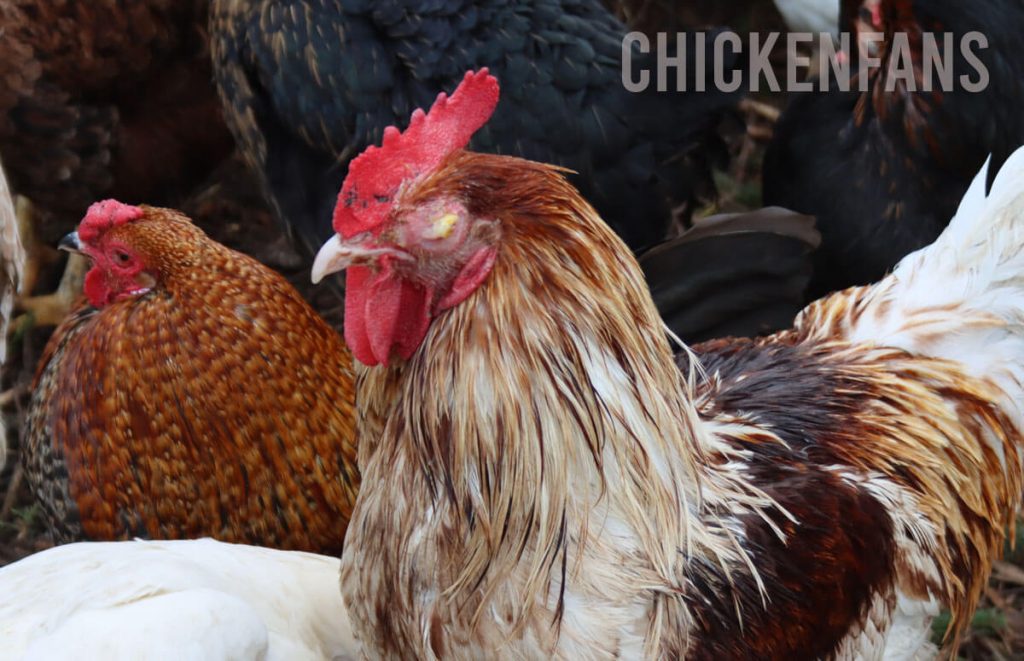
- Topical antibiotics (terramycin, moxifloxacin, tobramycin, ofloxacin) to fight the pathogen and prevent secondary infections
- Topical non-steroid anti-inflammatory drugs (NSAIDs) like flurbiprofen to reduce inflammation and relieve pain
- Topical corticosteroids (dexamethasone) also to manage inflammation and pain
- Artificial tears to keep the eye moist and lubricated (if the infection makes it dry)
Here are several things to consider when managing the symptoms of infection in chickens:
- When possible, use eye drops instead of ointments (ointments are greasy and can stain the featherings and make a mess)
- If going with ointments, use a Q-tip for application (this prevents the tube from contamination); also, use separate Q-tips for each eye
- Similarly, if going with drops, use a sterile syringe (without a needle); also, use separate syringes for each eye
- Be careful with corticosteroids, and do not use them without vet approval. They are systematically absorbed and can suppress the immune system or cause liver issues.
Regarding chickens, it is always preferable to use eye drops over ointments. This is because ointments can stain the featherings, thus making a mess.
Treating The Underlying Cause
This last step depends on the underlying cause. For example, simple removal is enough if a foreign body has caused the eye infection. However, the treatment includes systemic antibiotics if the underlying cause is bacteria.
12 Causes Of Eye Infections In Chickens
Chicken eye infections can be caused by physical injuries, chemical irritants, and infectious agents – bacteria, viruses, fungi, and parasites. Here is a close look at the 12 most common causes of eye infections in chickens.
1. Eye Injuries
Eye injuries in chickens often result in traumatic conjunctivitis. The most common eye traumas are caused by foreign material and bodies (like dust) or injuries (like excessive preening or pecking by other chickens).
The treatment depends on the cause and extent of the injury. In mild cases, flushing the eye with saline solution is enough.
Following that, you can apply a broad-spectrum topical antibiotic (terramycin, neomycin) to prevent secondary infections. However, in severe cases, veterinary attention is a must.
2. Ammonia Fumes
Prolonged or frequent exposure to ammonia fumes results in ammonia toxicity. Even in amounts that are not toxic, ammonia fumes irritate the eyes, causing eye infections.
Symptoms of ammonia-triggered eye infection include:
- Red and crusty eyes
- Swollen eyelids
- Wing-rubbing of the eyes
- Light sensitivity
The treatment is symptomatic. Adding Yucca schidigera extract to the feed (in the amount of 100-200 mg/kg) is helpful. Also, adjusting the chicken coop and reducing ammonia exposure with proper ventilation is essential.
3. Chronic Respiratory Disease (CRD)
Chronic respiratory disease is a serious condition affecting the entire respiratory system. It is caused by the bacterium Mycoplasma gallisepticum.
The bacteria is transmitted via contact with infected birds and through the eggs – from hens to chicks. Often, the disease is complicated by secondary bacteria (E. coli) and respiratory viruses.
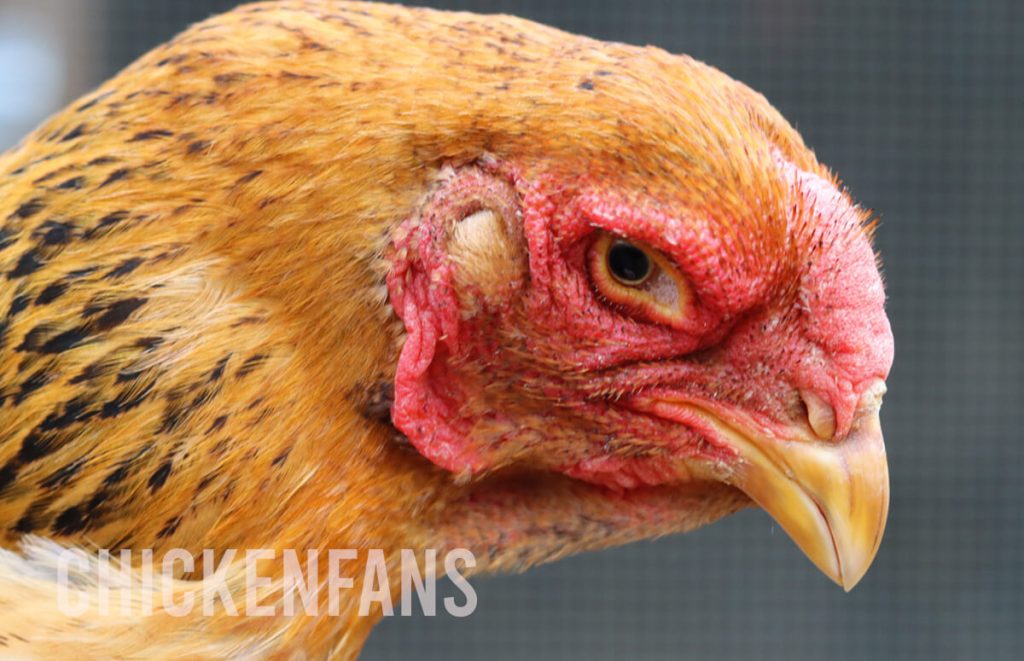
Chronic respiratory disease manifests with:
- Eye discharge, foamy bubbles, and tearing
- Nasal discharge
- Coughing and sneezing
- Open-beak breathing, yawning, head-shaking
- Gurgling and abnormal breathing sounds
The treatment includes the use of oral antibiotics, such as:
- Doxycycline: 25-50 mg/kg every 12-24 hours for about 21 days
- Tiamulin: 25-50 mg/kg every 24 hours for 3 days
When dealing with chronic respiratory disease, it is beneficial to supplement the chickens with probiotics. They help with potential lung injury and prevent gut microbiota imbalances in the case of E. coli complications.
4. Avian Chlamydiosis
Chlamydiosis is a zoonotic disease (meaning it can affect people). It is caused by the bacterium Chlamydia, and infections occur by inhaling contaminated dust (from feces or feathers).
Usually, chlamydiosis takes three forms – acute, subacute, and chronic. It causes:
- Green diarrhea, poor appetite, weight loss
- Sneezing, nasal discharge
- Eye discharge, red eyes, tearing
- Ruffles feathers
- Lethargy, depression
The treatment of avian chlamydiosis entails a long course of oral antibiotics, such as doxycycline, given at 25 mg/kg every 12 hours for 45 days.
5. Infectious Coryza (IC)
Infectious coryza is an acute disease of the upper respiratory tract. The causative agent is Avibacterium paragalliunarum. It is transmitted via direct and indirect contact with infected chickens.
Chickens with infectious coryza develop severe eye infections with excess eye discharge. As a result, they often keep their eyes partially or completely closed.
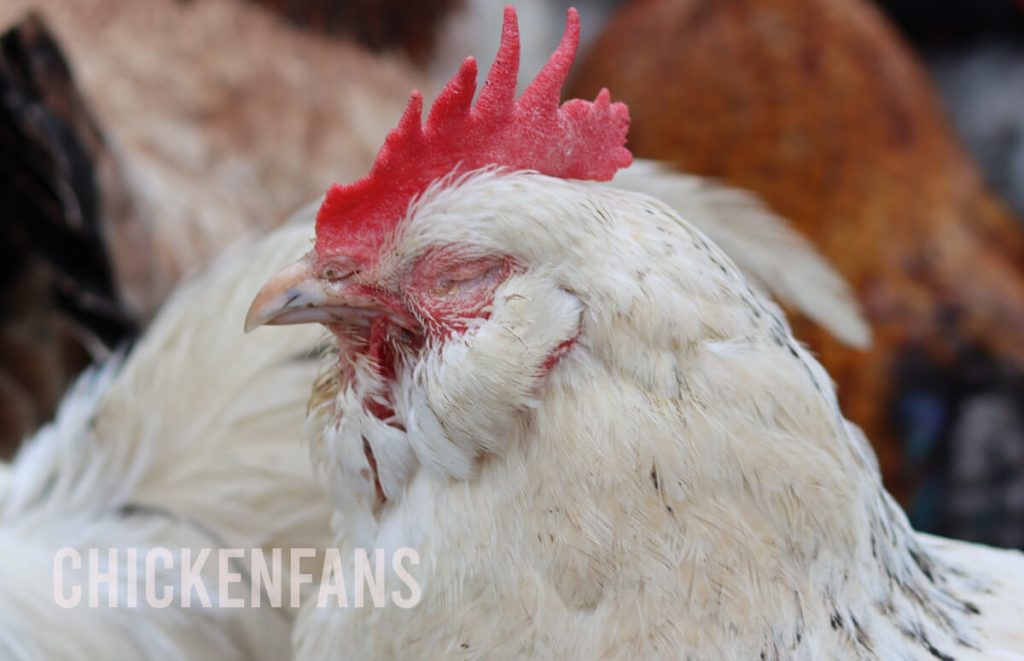
In addition to eye infections, coryza causes:
- Gurgling and abnormal breathing sounds
- Open-mouth breathing, yawning
- Change in voice
- Sneezing
- Head shaking
- Reduces appetite, diarrhea, weight loss
- Decreased egg production
- Ruffled feathers
Treating chickens will infectious coryza includes the use of antibiotics, such as:
- Enrofloxacin
- Oral syrup: 10-15 mg/kg every 12 hours
- Drinking water: 50 ml/L water (has a bitter taste, and it would be better to use other mediums, like, for example, sugar-free fruit juice)
- Sulfadimethoxine
- Orally: 25-50 mg/kg every 24 hours for 3-7 days
- Drinking water: initially a higher dose of 330-400 mg/L and then low doses of 200-265 mg/L for 4 days
- Tylosin: 250-1000 mg/L of drinking water
6. Infectious Laryngotracheitis (ILT)
Infectious laryngotracheitis is a very contagious condition of the upper respiratory tract. It is caused by the infectious laryngotracheitis virus (ILTV) or the Gallid Herpesvirus (GaHV-1).
The virus lives and reproduces in the trachea and conjunctiva. It spreads through direct and indirect contact with infected birds.
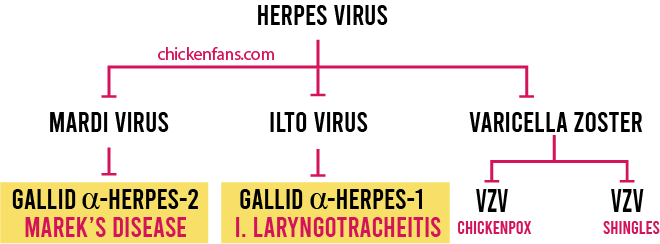
Infectious laryngotracheitis develops in two forms:
- Severe (Epizootic): hemorrhagic tracheitis (spraying bloody discharge when head shaking), sneezing, respiratory distress, gurgling sounds, eye infections, foamy bubbles in the eyes; has a high mortality rate
- Mild: mild conjunctivitis, sinusitis, and tracheitis; has a low mortality
There is no specific treatment for infectious laryngotracheitis. Colloidal silver can help with the symptoms and can be sprayed orally or applied on the nostrils for the chicken to inhale.
7. Infectious Bronchitis
Infectious bronchitis is inflammation of the bronchi caused by a Coronavirus. The virus is spread by air and feces from infected chickens.
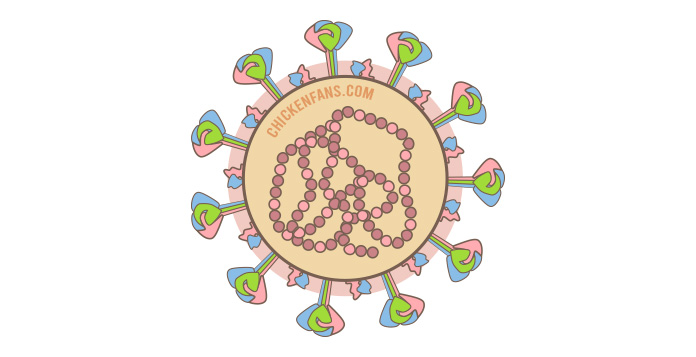
The disease manifests in three forms:
- Respiratory: This is the most common form of the disease and manifests with:
- Eye discharge, foamy eyes
- Nasal discharge
- Facial swelling
- Sneezing
- Gasping, yawning
- Gurgling and abnormal breathing sounds
- Respiratory distress
- Reproductive: Reduces egg production by as much as 50%, resulting in small, deformed, and shell-less eggs or eggs with calcium deposits.
- Kidney: This is the most severe form of the condition and has a high mortality rate.
There is no specific treatment for infectious bronchitis. The treatment is based on general supportive care and symptom management.
8. Avian Influenza (AI)
Avian influenza is a very contagious viral disease. The viruses causing the issue are classified into two groups:
- Low-pathogenic avian influenza (LPAI) viruses
- High-pathogenic avian influenza (HPAI) viruses
The first group causes respiratory disease, eye infections, and decreased egg production. The second group affects the visceral organs, cardiovascular system, and nervous system.
Chickens with LPAI viruses will manifest:
- Red and watery eyes
- Sneezing and coughing
- Nasal discharge
- Facial swelling
The treatment includes oral antivirals, such as:
- Amantadine (recently, there are reports about the virus becoming resistant to this drug)
- Orally: 25 mg/kg
- Drinking water: 100 mg/L of water for 10 days
- Rimantadine: 100 mg/L of drinking water
9. Swollen Head Syndrome (SHS)
Swollen head syndrome is an acute infection of the upper respiratory system. It is caused by the Avian Metapneumovirus (AMPV), transmitted through direct and indirect contact.
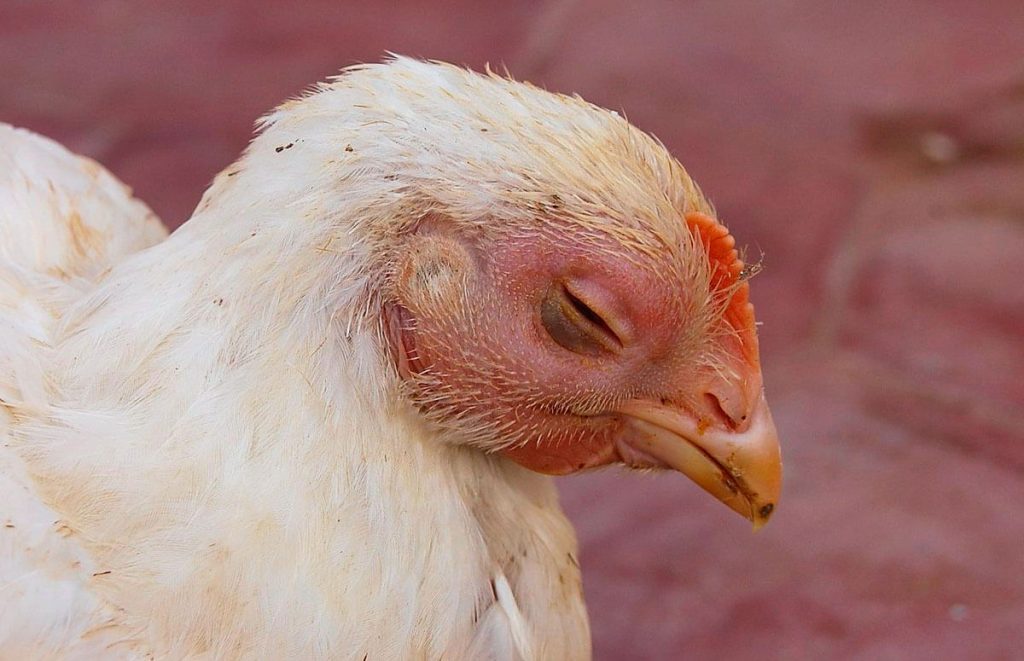
The disease causes:
- Conjunctivitis
- Facial swelling
- Nasal discharge
- Sneezing & coughing
There is no specific treatment for swollen head syndrome in chickens. In some cases, you can use broad-spectrum antibiotics to prevent secondary infections.
10. Aspergillosis
Aspergillosis is a common fungal infection of the chicken’s respiratory tract. It is caused by Aspergillus fumigatus (spreads by inhaling spores from contaminated feed and litter that are previously contaminated).
The mold is non-contagious, widespread, and opportunistic (linked to poor hygiene). High ammonia levels in the air, dusty environments, and cold stress increase the risk of infection.
Aspergillosis manifests in two forms:
- Acute Aspergillosis: Develops in young chicks and is commonly known as “brooder pneumonia”
- Chronic Aspergillosis: Occurs in adult chickens with compromised immune systems
In both forms, it causes:
- Red eyes with discharge
- Open-beak breathing
- Labored breathing
- Air-gasping
- Loss of appetite
The treatment is based on antifungals, such as:
- Ketoconazole: 10-30 mg/kg every 12 hours for 21 days
- Itraconazole: 5-10 mg/kg every 12 hours for 5 days and then every 24 hours for 16 days
- Amphotericin B: 1 mg/kg diluted in 1 ml of water every 8-12 hours in the form of intratracheal nasal flush
11. Eye Worms (Oxyspirurosis)
Eye worm or oxyspirurosis is a parasitic eye condition caused by the roundworm Oxyspirura mansoni. It is carried and transmitted through the Surinam cockroach (Pycnoscelus surinamensis), which serves as an intermediate host.
Oxyspirura mansoni is a small, white worm that attaches to the chicken’s eye (at the corner, just below the nictitating membrane. Chickens get the worm when they eat infected cockroaches.
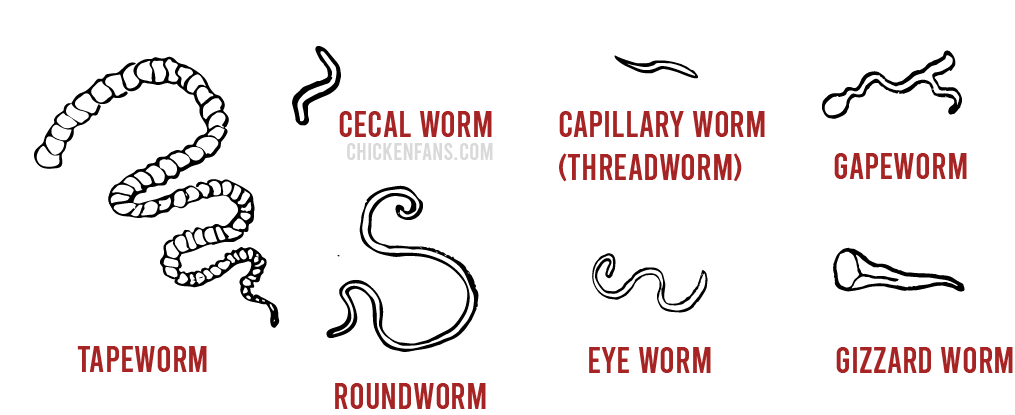
The worm’s presence causes discomfort and vision issues. Chickens with this worm develop signs and symptoms such as:
- Eye rubbing and scratching
- Eye discharge and increased tearing
- Light sensitivity
There are several treatment options for oxyspirurosis:
- Ivermectin: as eye drops or orally (1:10 dilution in the amount of 200 μg/kg)
- 5% cresol solution: 2 drops followed by eye flushing with sterile water
- Physical worm removal: done by a veterinarian
12. Cryptosporidiosis
Cryptosporidiosis is a parasitic disease caused by the protozoa Cryptosporidium. There are many Cryptosporidium species, but C. baileyi is the most common.
The parasite is opportunistic and usually infects immune-compromised chickens and young chicks. It is spread through feces from infected birds.
Cryptosporidiosis develops in two forms:
- Gastrointestinal: diarrhea, poor appetite, weight loss, ruffled feathers
- Respiratory: nasal discharge, eye discharge, sneezing, coughing, swollen sinuses, difficulty breathing
It’s the respiratory form that causes eye infections and discharge.
Cryptosporidiosis is treated with the antibiotic paromomycin. The medication should be diluted in dextrose and administered at the dose of 100 mg/kg every 12 hours for 5 to 7 days.
Summary
The avian eye is an organ that is vulnerable to infections due to its delicate nature. The treatment process for chicken eye infections involves three main aspects: supportive care, symptom management, and addressing the underlying cause. Eye infections in chickens are common and can occur independently or as part of more complicated conditions.

Dr. I. Crnec is a licensed veterinarian with several years of experience. She has published work on the effect of vitamin supplementation, egg-laying performances of chickens under heat-stress conditions and the effects of calcium supplementation on eggshell strength.
